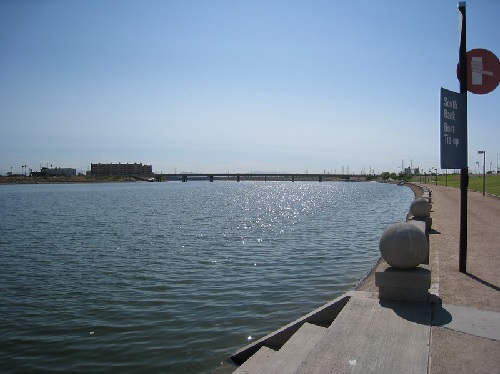After a brutal swim at the Half Ironman in Maine last year, I knew I’d be spending part of my off season practicing open water swimming. In the pool, I can see where I’m going, I have my own lane space, and I can put my feet down whenever I want. Open water swimming is the opposite of all that, plus I’m in a wetsuit. Mine has a lower neckline compared to other wetsuits, but it’s snug against my neck, especially when I rotate my body to be parallel to the ground to swim. I always have to remind myself that my wetsuit isn’t strangling me. (I’m really sensitive about things touching my neck.)
I did the Splash and Dash at Tempe Town Lake a few months ago. It had four race options:
- Swim 1,000 meters, Run 5K
- Swim only, 2,000 meters
- Swim 2,000 meters, Run 5K
- Swim only, 4,000 meters
I suspect the real purpose of this event is to give the people doing Ironman Arizona a few weeks later a chance to swim the length in the race (4,000 meters) in the lake where there’ll be swimming on race day. I signed up for the 2,000-meter, swim only.

I arrived at the lake at 6:50 a.m., checked in, and strapped my timing chip to ankle. The air temperature was 58 degrees. The water was 63. The 2,000-meter swim started at 7:32 a.m. They invited us to jump in a little before race time to “splash about†and get used to water temperature. Yeah, no thanks. I was only getting in that water once.
The race route was a 1,000-meter rectangle. Each person did one, two, or four laps depending on which event they signed up for. Like Maine, there were kayakers and paddle boarders throughout the route to help any swimmer who got in trouble. Shortly after I started swimming – 2:19 according to my Garmin – I grabbed onto a kayak, trying not to panic. (There’s something about feeling my wetsuit against my neck coupled with being hit by other swimmers that triggers my “fuck this†response.)
I told the friendly volunteer in the kayak, that I was panicking and he asked an insightful question, “Has this happened before?†That actually helped me calm down a bit. I took a minute to take some deep breaths and compose myself, and then continued with the race.
Once, I calmed down, running into other swimmers wasn’t as big of a deal. After one collision I remember saying, “Oops, that’s your butt.†The rest of the race felt pretty good. I worked on my spotting (trying to swim in a straight line by aiming at landmarks). A good rule is to check your spot every 2 strokes. I was doing it every 10, because I don’t like how spotting breaks up my cadence.
I finished the 2,000-meter swim in 45:03, 17 minutes faster than my time at Maine 70.3. The cut-off time for the swim for the full Ironman is 2 hours, 20 minutes (140 minutes). That’s encouraging to see that I’m on track to have a good swim at Ironman Mont Tremblant this summer.
I still need to work on not panicking when I first hit the water. I hope to do a few more open water group swims before the race.